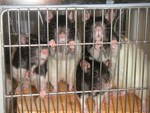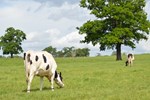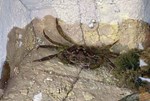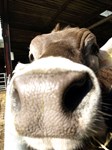Dr Troy Gibson
Department: Pathobiology & Population Sciences
Campus: Hawkshead
Research Groups: Animal Welfare Science and Ethics, Sustainable Food Systems, IRLFS (Research Programme), Brain Health and Behaviour
Research Centres: RVC Animal Welfare Science and Ethics
Troy is a Associate Professor in Animal Welfare Science. His research interest includes animal welfare during slaughter, painful husbandry procedures and vertebrate pest control. The focus of Troy's research is the development of practical approaches that aim to improve the welfare of animals under the influence of humans.
Troy graduated from Lincoln University (New Zealand) with a BSc in physiology in 2001. After spending two years working for a pharmaceutical company he returned to higher education and completed a PGDipSci with Distinction in physiology and PhD from Massey University (New Zealand).
In 2008 Troy joined the Royal Veterinary College first as a Research Associate in Animal Welfare Physiology, then Assistant Lecturer and in 2012 became a Lecturer in Animal Welfare Science. In 2017 Troy was promoted to Senior Lecturer.
Troy is a member of the UK Farm Animal Advisory Committee (AWC), RSPB Ethic Advisory Committee and the Zoological Scoiety of London (ZSL) Animal Welfare Committee.
Troy’s current research interests include animal welfare of livestock during routine husbandry procedures, welfare during slaughter and wildlife management.
Peer-reviewed papers
Daniel Santiago Rucinque, D.S., Velarde, A., Xercavins, A., Varvaró-Porter, A, Gibson, T.J., Michel, V., and Contreras-Jodar, A. (2024). Alternatives to the use of carbon dioxide in two phases for the stunning of broiler chickens at slaughter. Animals 14 (486) https://doi.org/10.3390/ani14030486
Fletcher, K.A., Hall, G.H., Limon, G., Padalino, B., Grist, A., and Gibson, T.J. (2023) Impact of social buffering and restraint on welfare indicators during UK commercial horse slaughter. Animals. 13 (2276) https://doi.org/10.3390/ani13142276
Roslan, N., Blackie, N., Slack, D., Abu-Basha, E., Ismail, Z., Guitian, J., and Gibson, T.J. (2022). Student Perceptions of the Introduction of Pig Production, Management, and Health Teaching into the Veterinary Curriculum of a Muslim-Majority Country: A Case Study in Jordan. The Journal of Veterinary Medical Education. https://doi.org/10.3138/jvme-2022-0013
Fletcher, K. A., Limon, G., Whatford, L., Grist, A., Knowles, T., and Gibson, T.J. (2022). A Systematic Review of equid welfare at slaughter. Livestock Science. (263). https://doi.org/10.1016/j.livsci.2022.104988
Owen, K., Blackie, N., and Gibson, T.J. (2022). The effect of needle reuse on piglet skin puncture force. Veterinary Science. 9 (2), https://doi.org/10.3390/vetsci9020090
Friedman, A., Dalla Costa, F.A., Dalla Costa, O.A., Godsell-Ryan, A., and Gibson, T.J. (2021). Time to Loss of Behavioural and Brainstem Responses of Ducks Following Non-Stunned Slaughter. Animals. 11 (3531). https://doi.org/10.3390/ani11123531
Dalla Costa, F.A., Gibson, T.J., Octavio Oliveira, S.E., Gregory, N.G., Faucitano, L., and Dalla Costa, O.A. (2021). On-farm dispatching methods used for pigs. Animal Welfare. 30, 507-522. https://doi.org/10.7120/09627286.30.3.008
Dalla Costa, F.A., Gibson, T.J., Octavio Oliveira, S.E., Gregory, N.G., Faucitano, L., and Dalla Costa, O.A. (2020). Evaluation of blunt force trauma for dispatching neonatal piglets on-farm. Journal of Animal Science. https://doi.org/10.1093/jas/skaa204
Gibson, T.J., King, E., Spence, J., and Limon, G. (2019). Pathophysiology of concussive non-penetrative captive bolt stunning of turkeys. Animals. 9 (1049). https://doi.org/10.3390/ani9121049
Hing, S., Hampton, J.O., and Gibson T.J. (2019). Animal welfare and the killing of wildlife by captive bolt in Australia. Australian Zoologist. https://doi.org/10.7882/AZ.2018.035
Gibson, T.J., Octavio Oliveira, S.E., Dalla Costa, F.A.,and Gregory, N.G. (2019). Electroencephalographic assessment of pneumatically powered penetrating and non-penetrating captive-bolt stunning of bulls. Meat Science.151, 54-59. https://doi.org/10.1016/j.meatsci.2019.01.006
Dalla Costa, F.A., Gibson, T.J., Octavio Oliveira, S.E., Gregory, N.G., Coldebella, A., Faucitano, L., and Dalla Costa, O.A. (2019). On-farm pig dispatch methods employed in Brazil and stockpeople attitudes on their use. Livestock Science.221, 1-5.https://doi.org/10.1016/j.livsci.2019.01.007
Octavio Oliveira, S.E., Dalla Costa, F.A., Gibson, T.J., Dalla Costa, O.A., Coldebella, A., and Gregory, N.G. (2018). Evaluation of brain damage resulting from penetrating and non–penetrating stunning in Nelore Cattle using pneumatically powered captive bolt guns. Meat Science. 145, 347-351. https://doi.org/10.1016/j.meatsci.2018.07.016
de la Cruz-Cruz, L., Gibson, T.J., Guerrero, I., Napolitano, F., Mora, P., and Mota-Rojas, D. (2018) The welfare of water buffaloes during the slaughter process. Livestock Production. 212, 22-33. https://doi.org/10.1016/j.livsci.2018.03.014
Octavio Oliveira, S.E., Gregory, N.G., Dalla Costa, F.A., Gibson, T.J., Dalla Costa, O.A., and Paranhos da Costa, M. (2018). Effects of high airline pressure in stunning cattle with pneumatically powered penetrating and non-penetrating captive bolt guns. Meat Science. 140, 9-13. https://doi.org/10.1016/j.meatsci.2018.02.010
Gibson, T.J., Rebelo, R.B., Gowers, T.A., and Chancellor, N. (2018) Electroencephalographic assessment of concussive non- penetrative captive-bolt stunning of turkeys. British Poultry Science. http://dx.doi.org/10.1080/00071668.2017.1401215
Hambleton, S.Y.N., and Gibson, T.J. (2017). A study investigating the attitudes and opinions of cattle farmers and veterinarians in the United Kingdom on the use of Non-Steroidal Anti-Inflammatory Drugs (NSAIDs) for post-disbudding analgesia of calves. 26, 323-334. Animal Welfare. https://doi.org/10.7120/09627286.26.3.323
Octavio Oliveira, S.E., Gregory, N.G., Dalla Costa, F.A., Gibson, T.J., Paranhos da Costa, M. (2017). Efficiency of low versus high airline pressure in stunning cattle with a pneumatically powered penetrating captive bolt gun. Meat Science. 130, 64-68. https://doi.org/10.1016/j.meatsci.2017.04.007
Gibson, T.J. & Jackson, E.L. (2017). The economics of animal welfare, OIE Scientific and Technical Review. 36, 125-135. 10.20506/rst.36.1.2616
Jackson, E., and Gibson, T. (2016). The economics of animal health and welfare. International Animal Health Journal, 3 (2), 14-18. http://animalhealthmedia.com/wp-content/uploads/2016/06/The-Economics.pdf
Gibson, T.J., Taylor, A.H., & Gregory, N.G. (2016). Assessment of the effectiveness of head only and back-of-the-head electrical stunning of chickens. British Poultry Science, 57 1-11. http://dx.doi.org/10.1080/00071668.2016.1156648
Limon, G., Gozales-Gustavson, E.A., and Gibson, T.J. (2016). Investigation of the humaneness of slaughter methods for guinea pigs (Cavia porcelus) in the Andean region. Journal of Applied Animal Welfare Science. http://dx.doi.org/10.1080/10888705.2016.1138116
Gibson, T.J., Dadios, N., and Gregory, N.G. (2015). Effect of neck cut position on time to collapse in halal slaughtered cattle. Meat Science. 110, 310-314. http://dx.doi.org/10.1016/j.meatsci.2015.03.026
Quy, R.J., Gibson, T.J., Lambert, M.S., Eason, C.T., and Gregory, N.G. (2015). Evaluation of a novel rodenticide: acute sub-lethal effects of a methaemoglobin-inducing agent. Animal Welfare. 24, 427-436. http://dx.doi.org/10.7120/09627286.24.4.427
Gibson, T.J., Quy, R.J., Eason, C.T., and Gregory, N.G. (2015). Welfare assessment of fatal methaemoglobinaemia in adult rats (Rattus norvegicus). Animal Welfare. 24, 417-425. http://dx.doi.org/10.7120/09627286.24.4.417
Gibson, T.J., Bedford, E.M., Chancellor, N., and Limon, G. (2015). Pathophysiology of free-bullet slaughter of horses and ponies. Meat Science. 108, 120-124. doi:10.1016/j.meatsci.2015.06.007
Sharp, T.M., McLeod, S.R., Leggett, K.E.A., and Gibson, T.J. (2015). Evaluation of spring-powered captive bolt guns for dispatch of kangaroo in-pouch young. Wildlife Research. 41, 623-632. http://dx.doi.org/10.1071/WR14094
Gibson, T.J., Whitehead, C., Taylor, O., Chancellor, N., and Limon, G. (2015). Pathophysiology of penetrating captive bolt stunning in Alpacas (Vicugna pacos). Meat Science. 100, 227-231. http://dx.doi.org/10.1016/j.meatsci.2014.10.022
Gibson, T.J., Mason, C.W., Spence, J.Y., Barker, H., and Gregory, N.G. (2014). Factors affecting penetrating captive bolt gun performance. Journal of Applied Animal Welfare Science. http://www.tandfonline.com/doi/full/10.1080/10888705.2014.980579
Bell, Y., Gibson, T.J., and Gregory, N.G. (2013). Procurement of equines for the horsemeat trade in Great Britain. Veterinary Record. Link
Gibson, T.J., Ridler, A.L., Lamb, C.R., Williams, A., Giles, S., and Gregory, N.G. (2012). Preliminary evaluation of the effectiveness of captive bolt guns as a killing method without exsanguination for horned and un-horned sheep. Animal Welfare. 21, S2, 35-42. ingentaconnect ID.
Gregory, N.G., von Wenzlawowicz, M., von Holleben, K., Fielding, HR., Gibson, TJ., and Kolesar, R. (2012). Complications during Halal slaughter and Shechita in cattle. Animal Welfare. 21, S2, 81-86. ingentaconnect ID.
Johnson, C.B., Gibson, T.J., Stafford, K.J., and Mellor, D.J. (2012). Pain perception at slaughter. Animal Welfare. 21, S2, 113-122. ingentaconnect ID.
Pickles, K.J., Gibson, T.J., Johnson, C.B., Walsh, V., Murrell, J.C., Madigan, J.E., (2011), Preliminary investigation of somatosensory evoked potentials in equine headshaking. Veterinary Record 168. Pubmed ID 21546406.
Gibson, T.J., Johnson C.B., Murrell, J.C., Hulls, C.M., Mitchinson S.L., Stafford K.J., Johnstone, A.C., and Mellor D.J. (2009). Electroencephalographic responses of halothane-anaesthetised calves to slaughter by ventral-neck incision without prior stunning. New Zealand Veterinary Journal. 57, 77-83. Pubmed ID 19471325.
Gibson, T.J., Johnson, C.B., Murrell, J.C., Stafford, K.J., Chambers, P.J., and Mellor, D.J. (2009). Components of electroencephalographic responses to slaughter in halothane-anaesthetised calves: Effects of cutting neck tissues compared with major blood vessels. New Zealand Veterinary Journal. 57, 84-89. Pubmed ID 19471326.
Gibson, T.J., Johnson, C.B., Murrell, J.C., Mitchinson, S.L., Stafford, K.J., and Mellor, D.J. (2009). Electroencephalographic response to concussive non-penetrating captive-bolt stunning in halothane-anaesthetised calves. New Zealand Veterinary Journal. 57, 90-95. Pubmed ID 19471327.
Gibson, T.J., Johnson, C.B., Murrell, J.C., Mitchinson, S.L., Stafford, K.J., and Mellor, D.J. (2009). Amelioration of electroencephalographic responses to slaughter by non-penetrative captive-bolt stunning after ventral neck incision in halothane-anaesthetised calves. New Zealand Veterinary Journal. 57, 96-101. Pubmed ID 19471328.
Mellor, D.J., Gibson, T.J., and Johnson, C.B. (2009) A re-evaluation of the need to stun calves prior to slaughter by ventral-neck incision: An introductory review. New Zealand Veterinary Journal. 57, 74-76. Pubmed ID 19471324.
Johnson, C.B., Murrell, J., Gibson, T.J., and Mellor, D.J. (2008). Innovative refinements to anaesthesia techniques can deliver pain research without pain. Proceedings of the 6th World Congress on Alternatives & Animal Use in the Life Sciences August 21-25, 2007, Tokyo, Japan. AATEX 14, Special Issue, 97-100.
Gibson, T.J., Johnson, C.B., Stafford, K.J., Mitchinson, S.L., and Mellor, D.J. (2007). Validation of the Acute Electroencephalographic Responses of Calves to Noxious Stimulus with Scoop Dehorning. New Zealand Veterinary Journal. 55, 152-157. Pubmed ID 17676078.
Non-peer reviewed publications
Jackson, E., and Gibson, T. (2016). The economics of animal health and welfare. International Animal Health Journal, 3 (2), 14-18. http://animalhealthmedia.com/wp-content/uploads/2016/06/The-Economics.pdf
Dalla Costa, F.A., Gibson, T.J., Octavio Oliveira, S.E., Gregory, N.G., Coldebella, A., Faucitano, L., and Dalla Costa, O.A. (2019). Levantamento dos métodos de eliminação (“eutanásia”) de suínos nas granjas e efeitos sobre o operador. Comunicado Técnico 559. Embrapa. Concórdia: Embrapa Suínos e Aves. http://www.infoteca.cnptia.embrapa.br/infoteca/handle/doc/1114061
Book chapters
Gallo, C., Schwartzkopf-Genswein, K., and Gibson, T. (2022). Cattle, Chapter 2. In Preslaughter handling of livestock,. Wageningen Academic.
Dalla Costa, F.A, Octávio Oliveira, S.E, Gibson, T.J, Ludtke, CB, and Dalla Costa, O.A. (2020). Eutanásia em granjas de suínos. In Boas práticas na suinocultura: o caminho para a saúde e o bem-estar únicos. Ministério da Agricultura, Pecuária e Abastecimento and Instituto Interamericano de Cooperação para a Agricultura. https://www.gov.br/agricultura/pt-br/assuntos/producao-animal/arquivos/suinocultura_umasaude_umbemestar.pdf
Mota, D., Gibson, T.J., Bolaños, D., Hartung, J., Guerroro, M. B. I. (2016). Controversias en el bienestar del porcino aturdido con CO2 Chapter 31. Bienestar animal. Elsevier
Gerritzen, T., and Gibson, T.J. (2016). Animal welfare at depopulation strategies during disease control actions, Chapter 11. In Animal welfare at slaughter (a practitioner book). 5m Publishing
Terlouw, C., and Gibson, T.J. (2016). Physiology and behaviour of food animals, Chapter 2. In Animal welfare at slaughter (a practitioner book). 5m Publishing
Since April 2012 Troy has been director of Animal Husbandry Extramural Studies (AHEMS) at the RVC, and between 2012-2023 the leader of the Animal Husbandry sub-strand. Troy lectures on Animal Welfare and Animal Husbandry to all years of the BVetMed course and to 2nd and 3rd year BSc Bioscience students. He is the module leader on the 3rd year BSc Applied Animal Welfare course. Troy tutors pre-clinical and clinical BVetMed students and supervises undergraduate and MSc, MRes and PhD students.
-
Assessing and Improving Animal Welfare
Genetics and management can greatly affect the welfare of farm, laboratory, companion and wild animals. We aim to improve animal welfare by understanding how human activities and management practices affect the welfare of animals that are kept, killed or otherwise impacted by humans. Comparative research can identify practices that generally elicit poor or good welfare outcomes, providing evidence that can be used to support initiatives to improve animal welfare.
-
Development of welfare assessment protocols and technology
Assessment of animal welfare is continually being improved using new insights in animal behaviour, non-invasive physiological methods, animal-environment interactions, and novel monitoring systems for animal responses and behaviours.
Some of our work aims to develop a more fundamental understanding of which measures (e.g. behaviour, activity, posture etc) should most appropriately be targeted with sensor technology. However, technology is not always feasible (or even desirable) in some sectors, so we develop welfare assessments that are valid and practical in whatever context they are needed and tailored to the specific welfare aim.
-
Ethics of animal use and management
Animal welfare issues often arise when there are conflicts of interest between humans and animals. This poses challenges around whose interests to prioritise, and what actions can be taken to produce the best moral outcome. The needs and wants of human, animal, and even environmental stakeholders must be understood and evaluated to decide what is the right course of action, but different ethicists and stakeholders may disagree about the conclusions of any ethical analysis. For example, unnecessary suffering must not be caused to legally protected animals, but what counts as ‘suffering’, when is it really ‘necessary’, and which animals should be protected? Evidence must be gathered and some consensus must be agreed upon as to weight the different possible actions.
-
Humane slaughter
Livestock and other animals are stunned and dispatch for slaughter, disease control and population management.
The RVC has a well-established Animal Welfare Science and Ethics research centre and members of the team study methods of stunning and dispatch of a variety of species in a variety of settings. The research is designed to help systems evolve and become more humane and less stressful for animals.
The research is shared with stakeholders, which enables them to make scientifically informed changes that reduce animal distress.




